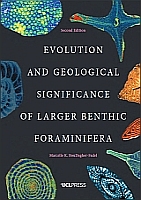Author success story
Context about the author:
Prof. Marcelle BouDagher-Fadel studied her first degree in Lebanon and at UCL she obtained her MSc and PhD. She was awarded a Royal Society Daphne Jackson Fellowship and held an Honorary Lectureship in the Department of Earth Sciences. In 2007 she was appointed as a Senior Research Associate in the UCL Office of Vice-Provost for Research and promoted to Professorial Research Fellow in 2016. She is a micropaleontologist with expertise in the study of planktonic and larger benthic foraminifera. She has an extensive publication record, with four major books and over 205 papers. She also has an established consultancy relationship with several oil and gas companies. Her website can be accessed here: http://www.ucl.ac.uk/EarthSci/people/fadel/home-mkf.htm
Please provide some background information on the research project, book origin, adjacent research, and/or network enabling the book
Biostratigraphic and Geological Significance of Planktonic Foraminifera, Updated 2nd edition
Many planktonic foraminiferal species are of worldwide occurrence and are found in broad latitudinal temperature belts. Their wide distribution and rapid evolution are a reflection of their successful colonisation of the pelagic realm. The role of the fossil planktonic foraminifera as markers for biostratigraphical zonation and correlation underpins most drilling of marine sedimentary sequences as well as being key to hydrocarbon exploration. This book puts together all data on planktonic foraminifera genera and their phylogenetic evolution in time and space. It also uses new unpublished data of carbonate thin sections with identified planktonic foraminifera from the Far East to offshore Brazil and South Africa in order to put together a comprehensive study on the nature and evolution of the planktonic foraminifera in both pelagic sediments and in shelf shallow water limestones. This book contributes information to a complete worldwide record of both solid and thin sectioned fossil planktonic foraminifera that has implications for the worldwide distribution of oceanographic parameters, controlling their habitats, and the distribution patterns for different time slices. It adds valuable information on how climatic change influenced the distribution of the biota and makes it possible to separate migration events from evolutionary appearances of taxa. Range charts are provided for all of the most important species. Extensively illustrated with over 100 high-quality plates, this work is an invaluable reference for all micropalaeontologists and biostratigraphers in industry and in academia throughout the world.
Evolution and Geological Significance of Larger Benthic Foraminifera, updated 2nd edition
Fossil larger benthic foraminifera, found in shallow marine carbonates, are used extensively in biostratigraphical applications, and to determine palaeoceanographic and palaeoclimatological context. Their role as markers for biostratigraphical zonation and correlation underpins most of the interpretation and exploration of the major hydrocarbon-bearing marine sedimentary basins. This volume provides the first general synthesis of this entire group of geologically significant microfossils.
This book brings together, for the first time, information on all the described genera from Carboniferous to Recent. Their taxonomy is reviewed and clarified, and illustrated using type specimens of many species as deposited in museums and university collections and in much original new research from the Far East, Middle East, South Africa, Tibet and the Americas. Their evolution and ecological significance is explained and their geographical and temporal distribution is analysed in terms of global events. Range charts are provided for all of the genera, as for the most important species. This is the first book to collate all known information on the evolution and distribution of the larger benthic foraminifera. Extensively illustrated with over 100 high-quality plates, this work is an invaluable reference for all micropalaeontologists and biostratigraphers in industry and in academia throughout the world.
What was/were your motivation(s) for wanting to publish this book?
The lack of collective data and information motivated me to write the two books on two different groups of foraminifera which are used worldwide for biostratigraphy and the palaeoenvironment. Another important consideration was the need to make available all the information I collected from the thousands of samples I studied for oil companies, international universities and collaborators throughout my years at UCL.
Please give some information on the funding behind the research / book / network
The samples were sent to me from all over the world so most of the work did not need any funding. I am grateful to the Vice Provost for Research, Prof. David Price who provided the space and funding that was necessary.
Was the book made available on your own website, or the website of any other editors or contributors, or your institution? If so, please state which.
The UCL website
Open access success story:
What makes this book successful?
Both books are unique and are invaluable reference works for all micropalaeontologists and biostratigraphers in industry and in academia throughout the world.
Why did you choose to publish this book open access?
To reach as wide an audience as possible. Both books were initially published by another publisher, and I had to withdraw the publishing rights before publishing the revised versions open access. The previous publisher was charging a large amount for both books and only privileged institutions or individuals were able to access them..
Do you think that open access publication helped the book and if so, why?
Yes definitely, both books reached a wider audience and especially in countries in which people generally could not afford to pay high prices. The larger benthic foraminifera book has also now been translated into Persian. Currently, Biostratigraphic and Geological Significance of Planktonic Foraminifera has been downloaded more than 35531 times in more than 156 countries and territories, and Evolution and Geological Significance of Larger Benthic Foraminifera has been downloaded more than 25070 times in more than 135 countries and territories.
Did your OA book show immediate success upon publication, or did the success unfold more slowly over time?
Both books were downloaded very successfully in numerous countries as soon as they were available open access.
If early signs of success started to show, did you try to reinforce this in an unusual or creative way?
It does not seem that the signs of success slowed down throughout the years, but the books have been regularly tweeted about by UCL Open Access and by many researchers.
Did open access help to reach unreachable / unknown / unexpected / new audiences? If yes, how do you know this?
Yes, it did and I know this from all of the countries that are now downloading it.
Did open access make new connections / follow-up possible?
Yes, I have been contacted by many scientists who asked for collaboration or help in their research.
Is there any long tail (awareness, citations, downloads) of this book that you consider would (most likely) not have happened with print sales only or toll-access?
Yes, in open access, both books reached a very wide audience and citations are high for each book – and, as I mentioned, one of them is even translated. However, when they were sold by the previous publisher they were reaching a very limited audience and citations were much lower.
How do you think academia can benefit from your book being OA?
Both books are free for students and they are very helpful for those who cannot afford the large amount that was charged by the previous publisher. Readers can open both books whenever they need to. They can download copies instead of buying them, and they don’t need to compete to find them in the library.
How do you think society at large can benefit from your book being OA?
Society can access all the information needed for research or exploration in easily and freely available books. Education and knowledge can spread easily in developing countries as well as in developed countries, which can make the world more equal.

This article is made available under a Creative Commons Attribution 4.0 International License.



